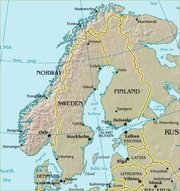Lake Ladoga
|
|
Lake Ladoga (Russian: Ладожское озеро (Ladozhskoye Ozero), Finnish: Laatokka) is the largest lake in Europe, located in Karelia and Leningrad Oblast in northwestern Russia (since WWII), near the border to Finland.
The area of the lake is 17,700 km² (approximately 6,800 square miles). It has about 660 islands with the total area of 435 km². Most of the islands are situated near the northwestern coast, including the famous Valaam islands. The lake drains into the Gulf of Finland of the Baltic Sea via river Neva.
The area of its basin is 276,000 km². The basin of the Ladoga Lake includes about 50,000 lakes and 3,500 rivers longer than 10 km. About 85% of the water income is due to the three most important tributaries:
- River Svir from lake Onega (south-east)
- River Vuoksi from lake Saimaa in Finland (west);
- Volkhov River from lake Ilmen (south).
Ladoga has its own endemic Ringed Seal subspecies.
The 2003 film Vozvrashcheniye, directed by Andrei Zvyagintsev, was filmed on and around Lake Ladoga and the Gulf of Finland.
Border between East and West
1617–1721 the border between Sweden and Russia was drawn through Lake Ladoga, like later 1812–1940 the border between Finland and Russia.
The 10th century Valamo Monastery was founded on the island of Valaam (Finnish: Valamo), the largest in Lake Ladoga, desolated 1611–1715, magnificently restored in the 18th century, and finally evacuated to Finland during the Winter War in 1940. In 1989 the monastic activities were started again.
During the siege of Leningrad, 1941–1944, lake Ladoga provided the only access to the besieged city. Supplies were transported into Leningrad (now St. Petersburg) with trucks on winter roads over the ice, the "Road of Life", and by boat in the summer.cs:Ladoské jezero da:Ladoga de:Ladogasee et:Laadoga järv es:Ladoga fr:Lac Ladoga nl:Ladogameer ja:ラドガ湖 no:Ladoga pl:Ładoga sk:Ladožské jazero fi:Laatokka sv:Ladoga

